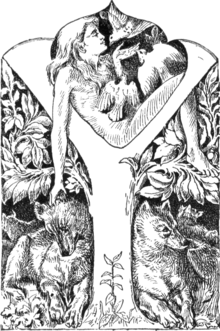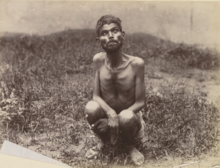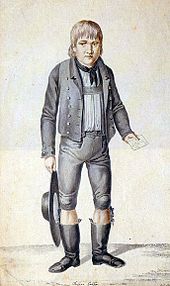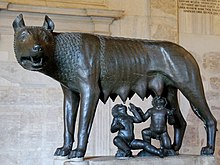
A feral child (also called wild child) is a young individual who has lived isolated from human contact from a very young age, with little or no experience of human care, social behavior, or language. Such children lack the basics of primary and secondary socialization.[1] The term is used to refer to children who have suffered severe abuse or trauma before being abandoned or running away. They are sometimes the subjects of folklore and legends, often portrayed as having been raised by animals. While there are many cases of children being found in proximity to wild animals, there are no eyewitness accounts of animals feeding human children.[2]
Feral children lack the basic social skills that are normally learned in the process of enculturation. For example, they may be unable to learn to use a toilet, have trouble learning to walk upright after walking on fours all their lives, or display a complete lack of interest in the human activity around them. They often seem mentally impaired and have almost insurmountable trouble learning a human language.[3] The impaired ability to learn a natural language after having been isolated for so many years is often attributed to the existence of a critical period for language learning, and taken as evidence in favor of the critical period hypothesis.[4][5]
There is little scientific knowledge about feral children. One of the best-documented cases has supposedly been that of sisters Amala and Kamala, described by Reverend J. A. L. Singh in 1926 as having been "raised by wolves" in a forest in India. French surgeon Serge Aroles, however, has persuasively argued that the case was a fraud, perpetrated by Singh in order to raise money for his orphanage. Child psychologist Bruno Bettelheim states that Amala and Kamala were born mentally and physically disabled.[6] Yet other scientific studies of feral children exist, such as the case of Genie.[5]
Prior to the 1600s, feral and wild children stories were usually limited to myths and legends. In those tales, the depiction of feral children included hunting for food, running on all fours instead of two, and not knowing language. Philosophers and scientists were interested in the concept of such children, and began to question if these children were part of a different species from the human family.
The question was taken seriously as science tried to name and categorize the development of humans, and the understanding of the natural world in the 18th and 19th century.[7] Around the 20th century, psychologists were attempting to differentiate between biological behavior and culture. Feral children who lived in isolation or with animals provided examples of this dilemma.


The historian Herodotus wrote that Egyptian pharaoh Psammetichus I (Psamtik) sought to discover the origin of language, and prove Egypt was the oldest people on Earth by conducting an experiment with two children. Allegedly, he gave two newborn babies to a shepherd, with the instructions that no one should speak to them, but that the shepherd should feed and care for them while listening to determine their first words. The hypothesis was that the first word would be uttered in the root language of all people. When both of the children cried βεκος (bekos) with outstretched arms, the shepherd concluded that the word was Phrygian because that was the sound of the Phrygian word for bread. Thus, they concluded that the Phrygians were an older people than the Egyptians.[52]
Following the 2008 disclosure by Belgian newspaper Le Soir[78] that the bestselling book Misha: A Mémoire of the Holocaust Years and movie Survivre avec les loups ("Surviving with Wolves") was a media hoax, the French media debated the credulity with which numerous cases of feral children have been unquestioningly accepted. Although there are numerous books on these children, almost none of them have been based on archives; the authors instead have used dubious second- or third-hand printed information. According to the French surgeon Serge Aroles, who wrote a general study of feral children based on archives (L'Enigme des Enfants-loups or The Enigma of Wolf-children, 2007), many alleged cases are totally fictitious stories:
|
Main article: List of fictional feral children |
Myths, legends, and fiction have depicted feral children reared by wild animals such as wolves, apes, monkeys, and bears. Famous examples include Romulus and Remus, Ibn Tufail's Hayy, Ibn al-Nafis' Kamil, Rudyard Kipling's Mowgli, Edgar Rice Burroughs's Tarzan, George of the Jungle and the legends of Atalanta and Enkidu.

Roman legend has it that Romulus and Remus, twin sons of Rhea Silvia and Mars, were suckled by a she-wolf. Rhea Silvia was a priestess, and when it was found that she had been pregnant and had children, King Amulius, who had usurped his brother's throne, ordered her to be buried alive and for the children to be killed. The servant who was given the order set them in a basket on the Tiber river instead, and the children were taken by Tiberinus, the river god, to the shore where a she-wolf found them and raised them until they were discovered as toddlers by a shepherd named Faustulus. He and his wife Acca Larentia, who had always wanted a child but never had one, raised the twins, who would later feature prominently in the events leading up to the founding of Rome (named after Romulus, who eventually killed Remus in a fight over whether the city should be founded on the Palatine Hill or the Aventine Hill).[82]
Legendary and fictional children are often depicted as growing up with relatively normal human intelligence and skills and an innate sense of culture or civilization, coupled with a healthy dose of survival instincts. Their integration into human society is made to seem relatively easy. One notable exception is Mowgli, for whom living with humans proved to be extremely difficult.
The book Knowledge of Angels involves a feral girl found on a fictional island based upon Mallorca. She is the subject of an experiment to see if the knowledge of God is learned or innate. Placed in a convent, while she is there the nuns are instructed not to teach her about God or even mention him in front of her. This is to see whether an atheist who washed up there should be condemned or not.
The Earthsea series by Ursula K. Le Guin mentions a brother and sister who were abandoned on a remote island as children, and thus grew up as feral children; in A Wizard of Earthsea, Ged washes up on their island and is unable to communicate much with them, as they only know a few words in their native language (which he did not speak at the time). They were both elderly and very frightened of him, but the sister gives him one of her few possessions when he leaves. Later in The Tombs of Atuan, Ged tells Tenar about the sister and brother (named Anthil and Ensar respectively), and Tenar explains their names, lineage, and how the abandonment was known about in their (and her) home country. Tenar and Ged agree that abandonment was kinder than the murder the children would have otherwise been victims of, but Ged remarks that it was still very cruel and "They scarcely knew human speech."
The 2006 novel Magic Hour by Kristin Hannah is about a six-year-old feral child living during her formative years inside a cave in the Olympic National Forest. The girl wanders one day into the fictional small town of Rain Valley, Washington, searching for food and carrying her pet wolf pup and unable to speak. The police chief calls in her psychiatrist sister to teach the girl how to speak and to find the girl's family.